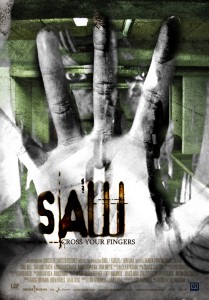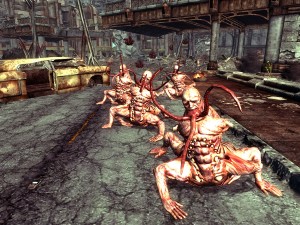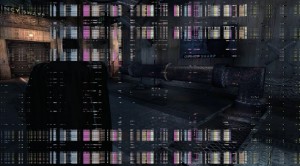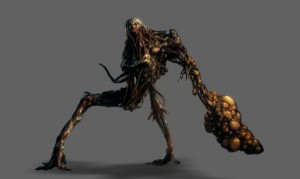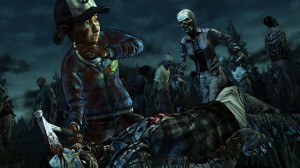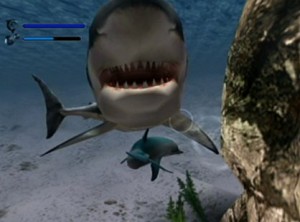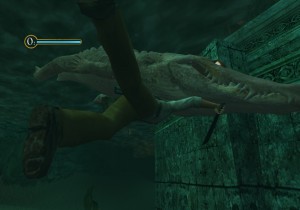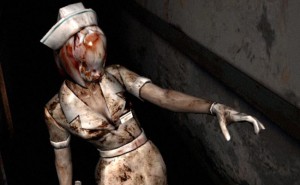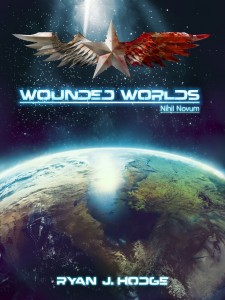-Ryan J. Hodge
For someone who enjoys a great story, is there anything better than a narrative that engages you from the very start? Imagine a world so rich you can almost smell the scents in the air, a delivery so clever it forces you to think in a way you never thought you would. I’m Ryan J. Hodge, author, and I’d like to talk to you about…video games.
Yes, video games. Those series of ‘bloops’ and blinking lights that –at least a while ago- society had seemed to convince itself had no redeeming qualities whatsoever. In this article series, I’m going to discuss how Donkey Kong, Grand Theft Auto, Call of Duty and even Candy Crush can change the way we tell stories forever.
What Video Games Teach Us About Horror
Halloween is coming up, which means that we as a society tend to start thinking about the creepy and the ghoulish. Fake tombstones start popping up on lawns, and paper skeletons start adorning schools. What’s more; ‘horror’ movies start to fill out the box office, and readers start reaching for Lovecraft, King, and Koontz. Yes, we all like a good scare from time to time…and yet how often does that bear out?
Does a sudden swell of strings paired with a smash-cut in a horror movie truly ‘scare’ us? It’s startling, sure, but does it leave you lying awake at night? Does it haunt your nightmares? For some it may, however I’d suspect that most would dismiss it as a ‘cheap thrill’ if pressed. Getting inside people’s heads to feel dread about something that does not even exist is a tricky thing to do. A single seam in the illusion can wreck the atmosphere and transform the story from ‘horrifying’ to ‘hilarious’.
When it comes to ‘scaring’ gamers, it’s even more difficult to sell the concept of fear. We gamers battle horrors from all corners of this world (and others) on a daily basis. We’re more frightened of being robbed of an achievement than anything Fallout can throw at us.
And yet, the horror genre exists in gaming just as it does in any other narrative medium. So, how do you scare someone who’s conquered all the demons of Hell before dinner?
Well, one of the most memorable attempts came from Batman: Arkham Asylum. This title isn’t even nominally a ‘horror’ game; however one of the villains the Caped Crusader is given to battle is ‘The Scarecrow’ (whose whole shtick is about ‘fear’). Over the course of the game, the player will face off against old Doc’ Crane multiple times and while these sequences can be a little disorienting, they don’t really reach the point of ‘scary’ until the final one.
This final challenge comes from nowhere, and is executed in such a fashion that it’s impossible to not provoke the player behind the controller. The game freezes, your speakers belch horrible noises, and your screen tears and fragments with every indication of a video card crash. The suggestion, therefore, is that the player’s machine was unable to handle the game in the real world and now they’ve got a very expensive problem on their hands. As someone who has had more than one video card give up the ghost on me, I can attest that the terror –the panic- that grips you in that instant is quite real. It’s a ruse of course, and gameplay continues as normal afterward, but I bought a can of compressed air to give my machine a thorough dusting the next day all the same.
While it’s difficult to imagine how this would translate on book or film (You can’t exactly set the theater on fire after all), this was a brilliant demonstration of how hitting your audience in a personal and relatable place is ten times scarier than the most grotesque monstrosity your CGI team can make. What made “Jaws” (1975 Film) so effective as opposed to say “Sharktopus” (2010 Film) was that the idea of a particularly large Great White terrorizing a beach community is of very real concern to a beach-going audience. A gestalt of tentacles and teeth? It would be terrifying if it actually existed, but we all know it doesn’t; so it’s not that frightening.
What doubled the effectiveness of “Jaws” was that the shark was not on a rampage, like so many archetypal monsters, but behaved more or less as any shark would. He ate his fill, and once his appetite was sated; he had no interest in molesting the swimmers of Amity Island further. The suggestion here, of course, is not whether an encounter with the shark is survivable due to alertness or quick reaction time, but purely based on the whims of the creature. While John Williams’ famous score may alert us as the audience when the shark is near, Jaws’ victims are always blissfully unaware until it’s too late…just like you would be were you to venture too far from shore.
This ‘grounded’ horror can be very effective, however, this is not to say that ‘cosmic’ or grotesque horrors cannot be effective at all. In the realm of gaming, one of the most famous examples of this is Dead Space. While it borrows many of its elements from “Alien” (1979 Film) in its cramped corridors and lonely atmosphere, Dead Space changes the combat formula of gameplay after a fashion many users weren’t expecting. In most games, a creature’s head or center of mass are primary player targets. This coincides with our very terrestrial notion of which areas of a given body, regardless of morphology, will house the vital organs. Not so in Dead Space. In order to defeat the horrific ‘Necromorphs’, players must strategically and systematically target the limbs or other segments of their opponents. However, this isn’t merely a matter of ‘swapping one target for another’, as successful dismemberments will actually change a given creature’s behavior (changing its method of locomotion, spawning new enemies, etc.).
The Necromorphs do not react to dismemberment the same way terrestrial creatures do. To them, losing a limb is more an inconvenience than a life-defining event. Their ability to constantly and unpredictably adapt sells the inscrutable ‘cosmic horror’ of it all. What’s more, the onus is on the player –the audience- to decide how to react to react to the creature before you in a very limited time. The challenge is no longer about who is fastest on the draw, or who spots whom first; but recognizing what quickly skittering limbs need to be cut first, then executing against that plan. Whether that particular stratagem will work is unknowable until tried, but certain death and horrific transformation into the scuttling horde shall be the result of failure.
A pervasive sense of ‘unknowable malevolence’ has been a staple of cosmic horror. H.P. Lovecraft’s “The Colour out of Space” (1927) tells the story of how a mysterious meteorite forever changed a small farming town. When the meteor hits, the land itself begins to change; yielding oddly colorful and yet bitter fruits and vegetables. While the effects of the impact initially strike the audience as little more than a trivial curiosity, increasingly treacherous and terrifying events begin to unfold; from madness taking hold of the farmhands to strange lights appearing in the boughs of dead trees. As the denizens of this small community struggle to comprehend what is happening, they don’t realize until it is too late that there is some intelligence at work. Whether it is sentient or purely instinctual, we can never know; we can only wonder what will await those who forget -however many years later that may be- that ‘Arkham’ was abandoned for a reason.
In this way, we see how developers and authors play with the deep-seeded fears of their audience on a macro scale. They show us things that we know we should be afraid of, and things we can’t even begin to fathom how to be afraid of.
However, fear is also a deeply primal thing. As panic sets in, a person’s decision making becomes more reactionary and geared more toward self-preservation than long-term planning. Motor functions decay and situational awareness suffers. Panic, therefore, can be a challenging thing to get right as an author as it requires an otherwise intelligent character to become momentarily stupid.
One game that does a fairly good facsimile of panic is Telltale’s The Walking Dead. Instead of presenting itself as an action game or first-person shooter (as one might assume for a Zombie Apocalypse scenario), The Walking Dead opts to be an ‘adventure’ game. This means that rather than an arsenal, the player will only have an extremely limited inventory; and must solve situations based on the tools in that inventory.
When combat unfolds, however, not only is the player forced to fight with whatever is on hand, but the game itself will actually work against him. His cross hair will jump and jiggle as unsteady hands tremble, the camera will zoom uncomfortably close on an approaching ‘walker’; making it impossible to plan how to cut through the rest of the horde, ammunition will drop to the ground as players struggle to reload, and bladed weapons must be physically wrenched from the corpses if sunk too deep.
All of this stands in stark contrast to the machine-like precision that normally accompanies player input commands in games, but it humanizes the player character far more. Dropped ammo and unsteady aim sells his inexperience with firearms. The tunnel vision and sluggish movement, impresses his apprehensive mental state onto the player. While even in Dead Space, a Necromorph encounter can become routine after a while, The Walking Dead takes great pains to make each engagement its own contained scenario. As such, it forces its audience to react and adapt within a very brief time window while never getting stale.
In addition to fear’s primal nature, it is also extremely personal. For instance, my most intense nightmares often involve being perched precariously just above a murky plane of water with vague yet sinister shapes barely visible beneath the surface. It comes as no surprise, then, that the most sweat inducing levels I’ve ever played have been against underwater adversaries. Included among these are:
The Great White from Ecco the Dolphin (DOTF)…
…And the Albino Crocodile from “Indiana Jones and the Emperor’s Tomb”
While neither of these are horror games, having your own deepest fears thrown back in your face is, perhaps, the most terrible things that can be done to a person. While these events were simulated, this theme is explored further in Sphere (Michael Crichton, 1987). In this story, the characters are assailed by their own ‘manifestations’: creatures made flesh by their own imaginations. As the plot unfolds, who is imagining what becomes a subject of great concern and paranoia among the characters; making each of them simultaneously a hero and villain in their own story.
However, the story of Sphere is only so long. Gamers know that if they want to gaze into the depths of self-abusive madness, they pick up Silent Hill 2. As James Sunderland, players find themselves in the eponymous monster-filled town at the behest of James’ thought-to-be-deceased wife. As they explore the fog-blanketed town, they discover that not all monsters act alike. While some are decidedly deadly, others are benign if a bit disturbing. At length, the player will come to realize that these monsters are representations of James’ shattered psyche; the buxom, faceless nurses –for example- being a manifestation of his own guilty lustful desires as his own wife lay dying in the hospital.
Players have also interpreted the main antagonist, ‘Pyramid Head’, to be James’ suppressed desire to be punished when it is revealed that Mr. Sunderland had actually ‘euthanized’ his terminal spouse rather than allow her to linger with her illness. All of this, of course, unfolds at the player’s own pace. Rather than having it explained in exposition, it is often left to the audience to join these dots themselves.
It can be difficult to simply ‘show’ something scary to someone and expect them to be scared. Particularly when you may not be sure what scares yourself and how you’ll handle it when confronted with horror. But games will be more than happy to thrust the controller in your hand and demand that you act when all you’d like to do is flee. So insert the disk…if you dare. Who knows? It just might make you a better writer.
Ryan J. Hodge is a Science Fiction author and works for Konami Digital Entertainment US (His opinions are his own). His latest book, Wounded Worlds: Nihil Novum, is available now for eBook & Paperback.
Media
Batman: Arkham Asylum (2009) d.Rocksteady p.Warner Bros. -multiplatform
The Colour out of Space (1927) H.P. Lovecraft, Amazing Stories
Dead Space (2008) d.p.Electronic Arts -multiplatform
Ecco the Dolphin: Defender of the Future (2000) d.Appaloosa Entertainment p.Sega –Sega Dreamcast
Fallout 3 (2008) d.p.Bethesda –multiplatform
Indiana Jones and the Emperor’s Tomb (2003) d.The Collective p.LucasArts -multiplatform
Jaws (1975) Universal Pictures
Silent Hill 2 (2001) d.p. Konami –Sony Playstation 2
Sphere (1987) Michael Crichton, Knopf
The Walking Dead (2012) d.p. Telltale -multiplatform


